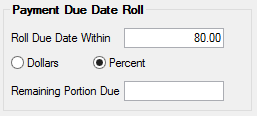
|
WARNING: This field should be used with care.
|
When entering data in this field, you should also select either the Dollars or Percent radio button below.
•To enter a value of 80 dollars, type "80.00" and select the Dollars radio button. •To enter a value of 80 percent, type "80.00" in this field and select the Percent radio button.
With a percentage in this field, only that percentage of the payment amount must be paid in order to advance the due date. If there is a dollar amount in this field, anything up to that amount can be left unpaid and the due date will advance. See the following examples:
Example 1: Loan payment amount is $120.00. If "80.00" is entered in this field and Percent is selected, then the loan due date will advance one frequency if 80% (96.00) or more of the loan payment is processed.
$120.00 x 80.00 = $96.00
Example 2: Loan payment amount is $120.00. If "25.00" is entered in this field and Dollars is selected, then the loan due date will advance one frequency if $95.00 or more of the loan payment is processed
$120.00 - $25.00 = $95.00
In both examples the interest portion of the amount not paid will remain in accrued interest. What your institution is doing by accepting less than the amount due is deferring to an undetermined time all other portions of the payment.
For payment method 5, 9, or 10 loans, the amount unpaid is not stored separately. The interest portion of the amount unpaid will eventually be collected because it remains in accrued interest; however, it cannot be billed as a separate item. (If $100.00 was due and you accepted $80.00, the next billing does not indicate that $20.00 is still due. If part of the $20.00 is interest, that portion remains in accrued interest but is never added separately to a billing.)
For payment method 3 or 6 loans, the amount unpaid is stored in the Remaining Portion Due field. This amount is then included in the Total Due field on the bill and receipt statements (FPSRP003 and FPSRP155).
An example of how the Remaining Portion Due field works is as follows:
Loan "A" has a payment due of $100.00 and a roll limit of 80%. The customer pays $85.00, the due date advances and the remaining portion due will be increased by $15.00. The next payment due will still be $100.00. On the billing statement, the customer's amount due will be $115.00 (payment due plus remaining unpaid). The following are examples of what could happen when posting the next payment:
1.If the customer pays $80.00 next month, the remaining portion due will decrease to $0.00, the Applied To Payment field will increase to $65.00, and the due date does not advance. ($80.00 - $15.00 = $65.00 which is less than the due date roll limit.)
2.If the customer pays $110.00 next month, the remaining portion due will decrease to $5.00, and the due date advances. ($110.00 -$15.00 = ($95.00 - $100.00 = $5.00-.)
3.If the customer pays $115.00 next month, the remaining portion due will decrease to $0.00, and the due date advances. ($115.00 - $15.00 = ($100.00 - $100.00 = $0.00.)
4.If the customer pays $125.00 next month, the remaining portion due will decrease to $0.00, the Applied To Payment field will increase by $10.00, and the due date advances. ($125.00 - $15.00 = ($110.00 - $100.00 = $10.00.)
5.If the customer pays $95.00 next month, the remaining portion due will decrease to $20.00, and the due date advances. {($95.00 - $15.00 = ($80.00 - $100.00 = $20.00-).}
For payment method 3, 5, and 6 loans, when multiple payments are posted at the same time, full payments are processed until up to the last payment. The system then uses these fields to determine if it can advance the due date.
Example: Two payments at $100 are due and $180 is received. The first payment of $100 is processed and the due date advanced. The second payment of $80.00 is compared to the Roll Due Date Within field to determine if the due date should be advanced.
Late charges are not taken into consideration in determining the dollar or percentage portion of the payment. For instance, if the Payment Application is late charge, then principal, then interest (421), the system will first take the late charge and then perform the percentage or dollar calculation to determine when to advance the due date.
For payment method 3 and 6 loans, this field works with the Applied To Payment field. The system will include the amount in the Applied To Payment field in determining whether the applicable dollar or percentage amount has been received.
For payment method 5 loans, this field is only applicable to the Payment Unpaid Portion (Loans > Account Information > Consumer Line-of-Credit screen, Information tab) after a billing has occurred. Once the billing process is complete, payments are applied to the oldest unpaid billing field.
The percent option only evaluates the unpaid billing amount. For example, after the billing process both the billed amount and the unpaid billed amount fields contain $100.00. The Roll Due Date Within field is 90.00 and Percent is selected. The payment received is $80.00. The billed amount field remains at $100.00 and the unpaid billed amount is reduced to $20.00. Because the option is set to 90% of the next payment, the borrower will have to make an $18.00 payment (90% of the remaining $20.00) in order to advance the due date.
For GOLDWriter, the type will be “Y” for percent and “N” for dollar. Also, because the default is “D,” you will never get a blank.
|
